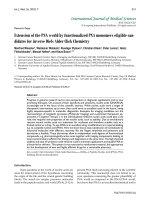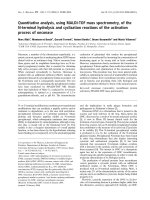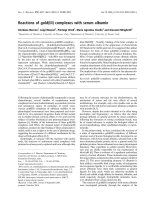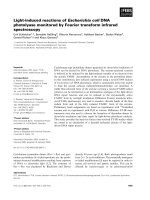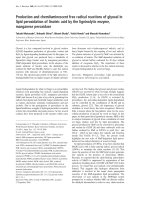Chiral bicyclic guanidine catalyzed diels alder reactions of anthrones
Bạn đang xem bản rút gọn của tài liệu. Xem và tải ngay bản đầy đủ của tài liệu tại đây (3.1 MB, 215 trang )
CHIRAL BICYCLIC GUANIDINE CATALYZED
DIELS–ALDER REACTIONS OF ANTHRONES
SHEN JUAN
NATIONAL UNIVERSITY OF SINGAPORE
2008
CHIRAL BICYCLIC GUANIDINE CATALYZED SHEN JUAN 2008
DIELS–ALDER REACTIONS OF ANTHRONES
CHIRAL BICYCLIC GUANIDINE CATALYZED
DIELS–ALDER REACTIONS OF ANTHRONES
SHEN JUAN
(BSc., Suzhou University)
A THESIS SUBMITTED
FOR THE DEGREE OF DOCTOR OF PHILOSOPHY
DEPARTMENT OF CHEMISTRY
NATIONAL UNIVERSITY OF SINGAPORE
To my parents, brother, and Dongsheng,
for their love, support, and encouragement
Acknowledgements
First and foremost, I would like to take this opportunity to thank my supervisor,
Assistant Professor Tan Choon-Hong, for his guidance and encouragement throughout
my PhD research and study.
I appreciate Mr. Santhosh’s help in proofreading this manuscript. Miss Loh Wei
Tian, Miss Lin Shishi and Mr. Lee Zhong Han’s suggestions and comments also
helped improve this thesis.
I would also like to thank all my labmates for creating such a harmonious,
encouraging, and helpful working environment. My special thanks go to Ms. Thanh
Truc Nguyen, Mr. Yong-Peng Goh, and Ms. Junye Xu, for their participation in
different stages of this project.
I thank Mdm Han Yanhui, Miss Ler Peggy and Mr. Wong Chee Ping for their
assistance in NMR analysis, and Mdm Wong Lai Kwai and Mdm Lai Hui Ngee for
their assistance in Mass analysis as well. I also owe my thanks to many other people
in NUS chemistry department, for their help and assistance from time to time.
Last but not least, I thank all my friends in Singapore who helped me settle down
at the beginning. Singapore is a great place and I enjoy the life here.
Table of Contents
Summary
List of Schemes
List of Tables
List of Figures
List of Abbreviations
Chapter 1
Chiral Guanidine and Guanidinium Derivatives as Asymmetric Catalysts 15
Chapter 2
Chiral Bicyclic Guanidines Catalyzed Reactions of Anthrones
2.1 Brønsted-Base Catalyzed Diels-Alder Reaction 42
2.2 Chiral Bicyclic Guanidine Catalyzed Diels–Alder Reactions of Anthrones 55
Chapter 3
Mechanistic and Kinetic Studies of Guanidine Catalyzed Enantioselective
Diels–Alder Reactions of Anthrones
3.1 Introduction to Previous Mechanistic Studies on Various Organocatalytic
Reactions 73
3.2 Kinetic Analysis using monofunctional base 75
3.3 Kinetic Analysis using bifunctional chiral guanidine 80
3.4 Mechanistic Possibilities for chiral reaction 85
Chapter 4
Anthrone-Derived NHPI Analogues as Catalysts in Reactions Using Oxygen as an
Oxidant
4.1 Enantioselective Synthesis of Anthrone-Derived NHPI Analogues 94
4.2 Asymmetric Aerobic Oxidation of Benzylic Compounds and Diols Catalyzed by
Anthrone-Derived NHPI Analogues with Co(II) 96
4.3 Aerobic Radical addition of dioxolanes or alcohols to activated alkenes
Catalyzed by Anthrone-Derived NHPI Analogues with Co(II)
98
Chapter 5
Experimental Procedures
5.1 General Procedures 103
5.2 Preparation and characterization of dienes and dienophiles 104
5.3 Procedures for the Synthesis of Chiral Bicyclic Guanidines 107
5.4 Typical Experimental Protocols for the Reactions of Anthrones 111
5.5 X-ray ORTEP diagrams 133
5.6 Mechanistic and Kinetic Studies of Guanidine Catalyzed Enantioselective
Diels-Alder Reactions 137
5.7 Anthrone-Derived NHPI Analogues as Catalysts in Reactions Using Oxygen as
an Oxidant 155
References 166
Appendix 178
Publications 210
Summary
The aim of this study is to develop highly enantioselective Diels–Alder reactions
of anthrones catalyzed by a chiral bicyclic guanidine.
We try to find an efficient type of catalyst, and three categories of catalysts were
screened for the Diels–Alder reaction between anthrone and N-phenylmaleimide,
including bis(oxazoline) (BOX), imidazoles, guanidines.
2,3,5,6-Tetrahydro-2,6-dibenzyl-1H-imidazo[1,2-a]imidazole, a bicyclic guanidine
base, was found to be the most efficient organocatalyst. A wide variety of Diels–Alder
dienes and dienophiles can participate in these reactions using 10 mol% of the chiral
bicyclic guanidine. The conjugate addition between
1,8-dihydroxy-9(10H)-anthracenone (dithranol) and different dienophiles also works
very well with the chiral bicyclic guanidine. These reactions are mild, fast, easy to
perform, and proceed with high yields. The enantioselectivities generally range from
85-99%, with yields between 80-96%.
The mechanism of both triethylamine (Et
3
N) and
2,3,5,6-tetrahydro-2,6-dibenzyl-1H-imidazo[1,2-a]imidazole catalyzed reactions of
anthrones has been investigated though VT-NMR. When using Et
3
N as the catalyst, it
fouctions as a normal base to abstract a proton from anthrone. The anthrone works a
reactive diene in Diels-Alder reaction. When chiral bicyclic guanidine was used as the
catalyst, it works as a bifunctional catalyst; it activates both the diene and dienophile
at defined positions simultaneously.
An enantioselective synthesis of anthrone-derived N-hydroxyphthalimide (NHPI)
analogues has been developed. One of these analogues, in combination with Co salts,
was employed to catalyse the aerobic oxidation of benzylic compounds and diols.
Exploratory studies using a racemic version of the catalyst were also conducted.
Radical addition of dioxolanes or alcohols to activated alkenes with molecular oxygen
as the terminal oxidant was also shown to be catalysed with NHPI-analogues.
List of Schemes
Scheme 1.1
Isolated complex between TBD and phenyl nitromethane.
Scheme 1.2
Henry reaction catalyzed by homochiral guanidine.
Scheme 1.3
Diastereoselective Henry reaction catalyzed by chiral guanidines.
Scheme 1.4
Lipton’s cyclic dipeptide catalyzed Strecker reaction.
Scheme 1.5
Ma and Cheng’s chiral guanidine catalyzed Michael reaction of
glycinate.
Scheme 1.6
Ma’s chiral guanidine catalyzed Michael reaction and Diels-Alder
reaction between anthrone and maleimide.
Scheme 1.7
Ishikawa’s chiral guanidine catalyzed Michael reaction of glycinate.
Scheme 1.8
Guanidine promoted epoxidation of chalcone.
Scheme 1.9
Guanidine promoted epoxidation.
Scheme 1.10
Chiral bicyclic guanidinium salt catalyzed aza-Michael reaction.
Scheme 1.11
Chiral guanidine or guanidinium catalyzed nitro Michael reaction.
Scheme 1.12
Chiral guanidine catalyzed asymmetric silylation of secondary
alcohol.
Scheme 1.13
Chiral guanidine catalyzed TMS cyanation of aliphatic aldehydes 5.
Scheme 1.14
Chiral guanidine mediated azidation of (±)-1-indanol 44a.
Scheme 1.15
Corey’s bicyclic guanidine catalyzed Strecker reaction.
Scheme 1.16
Chiral bicyclic guanidine catalyzed Michael reactions of ethyl
maleimide and 1,3-diketones, β-keto esters, dithiomalonates.
Scheme 1.17
Chiral bicyclic guanidine catalyzed Michael reactions of cyclic enones
and furanone.
Scheme 1.18
Chiral bicyclic guanidine catalyzed Michael reactions of alkyl
trans-4-oxo-4-arylbutenoates.
Scheme 1.19
Chiral bicyclic guanidine catalyzed phospha-Michael reactions with
various diaryl phosphine oxides.
Scheme 1.20
Chiral bicyclic guanidine catalyzed phospha-Michael reactions of aryl
nitroalkenes.
Scheme 1.21
Phospha-Michael reaction between phosphine oxide and trisubstituted
nitroalkenes.
Scheme 1.22
Terada’s axially chiral guanidine catalyzed Michael reaction of
nitroalkene.
Scheme 1.23
Terada’s axially chiral guanidine catalyzed electrophilic aminations
reactions.
Scheme 1.24
Enantioselective 1,4-addition reaction of β-nitrostyrene with diphenyl
phosphite catalyzed by various axially chiral guanidines.
Scheme 1.25
Terada’s axially chiral guanidine catalyzed 1, 4-addition reactions of
diphenyl phosphite to various nitroalkens.
Scheme 1.26
Guanidinium slat catalyzed phase transfer epoxidation.
Scheme 1.27
Chiral pentacyclic guanidinium salt catalyzed phase transfer
alkylation.
Scheme 1.28
Chiral tetracyclic guanidinium salt catalyzed phase transfer alkylation.
Scheme 1.29
Diastereoselective Henry reaction catalyzed by a guanidine-thiourea
catalyst.
Scheme 1.30
Asymmetric Henry reaction catalyzed by guanidine-thiourea
organocatalyst.
Scheme 2.1
Base catalyzed Diels–Alder reacton of 3-hydroxy-2-pyrone.
Scheme 2.2
Asymmetric Diels–Alder reaction of 3-hydroxy-2-pyrone.
Scheme 2.3
Cinchona alkaloids catalyzed Diels–Alder reaction of
3-hydroxy-2-pyrone.
Scheme 2.4
Diels–Alder reaction between 3-hydroxy-2-pyrone with unreactive
dienophile catalyzed by 88a.
Scheme 2.5
Diels–Alder reaction of 3-hydroxy-2-pyrone catalyzed by 91.
Scheme 2.6
Asymmetric base-catalyzed Diels–Alder reaction of
3-hydroxy-2-pyrone with chiral acrylated derivatives.
Scheme 2.7
Synthesis of (+)-epiepoformin and (–)-theobroxide.
Scheme 2.8
Base-catalyzed reactions of N-tosyl-3-hydroxy-2-pyrone.
Scheme 2.9
Synthetic route of three validamine type compounds.
Scheme 2.10
Synthesis of Tamiflu intermediates.
Scheme 2.11
Base catalyzed reactions of anthrones.
Scheme 2.12
Alkaloid catalyzed Diels–Alder reaction of anthrone.
Scheme 2.13
Double asymmetric synthesis with chiral N-substituted meleimides
and C
2
-pyrrolidine.
Scheme 2.14
Hydroxy-pyrrolidine catalyzed Diels-Alder reaction between anthrone
and phenylmaleimide.
Scheme 2.15
Standard synthesis of anthrone derivatives.
Scheme 2.16
Mechanism for the formation of anthrone derivatives from
anthroquinones.
Scheme 2.17
Catalytic asymmetric Diels–Alder reaction of anthrone 19a with
N-phenyl maleimide 20b.
Scheme 2.18
Synthesis of symmetrical chiral bicyclic guanidines.
Scheme 2.19
Chiral bicyclic guanidine 124d catalyzed Diels–Alder reaction of
anthrone 19a with N-phenyl maleimide 20b in different conditions
Scheme 2.20
Chiral bicyclic guanidine-catalyzed Diels–Alder reactions between
substituted anthrones and maleimides
Scheme 3.1
Et
3
N catalyzed reaction between anthrone 19a and phenylmaleimide
21b.
Scheme 3.2
Proposed non-chiral catalytic cycle.
Scheme 3.3
Chiral Bicyclic Guanidine-Catalyzed Diels–Alder Reaction between
Anthrone 19a and Phenylmaleimide 20b.
Scheme 3.4
Proposed catalytic cycle in the chiral bicyclic guanidine catalyzed
Diels–Alder reaction.
Scheme 4.1
Synthesis of chiral anthrone-derived NHPI analogues.
List of Tables
Table 2.1
Synthesis of various anthrones.
Table 2.2
Various chiral catalysts in catalytic asymmetric Diels–Alder reaction of
anthrone 19a with N-phenyl maleimide 20b.
Table 2.3
Solvent and temperature effects on the Diels–Alder reaction of anthrone
19a with N-phenyl maleimide 20a (Scheme 2.19).
Table 2.4
Chiral guanidine 124d catalyzed Diels–Alder reaction of anthrone and
various maleimides (Scheme 2.20).
Table 2.5
Chiral bicyclic guanidine-catalyzed Diels–Alder reactions between
dithranol and various maleimides.
Table 2.6
Chiral bicyclic guanidine-catalyzed Diels–Alder reactions between
dithranol and various acyclic conjugated olefins.
Table 3.1
Rate constants of Et
3
N catalyzed Diels–Alder reaction of Anthrone.
Table 3.2
Order of Et
3
N.
Table 3.3
VT-NMR Experiments of Et
3
N catalyzed Diels–Alder reaction of
Anthrone.
Table 3.4
Kinetic study of chiral guanidine catalyzed Diels–Alder reaction of
anthrone.
Table 3.5
Order of chiral bicyclic guanidine catalyst 124d.
Table 3.6
1
H NMR study of 20b, 124d and their mixture in CD
2
Cl
2
.
Table 3.7
VT-NMR Experiments of chiral guanidine catalyzed Diels–Alder
reaction of anthrone.
Table 4.1
Chiral bicyclic guanidine-catalysed Diels–Alder reactions between
substituted anthrones and maleimides.
Table 4.2
Hydroxyacylation of alkenes using 1,3-dioxolanes and dioxygen.
List of Figures
Fig. 1.1
Pre-transition-state 52 for the Strecker reactions of N-benzhydryl
benzaldimine 12a and N-benzhydryl pivalaldimine 12i.
Fig. 2.1
Bifunctional catalysis for Diels-Alder reactions of 2-pyrone 85.
Fig. 2.2
Tamiflu and Corey’s intermediate.
Fig. 2.3
Transformation between 21a and 22.
Fig. 2.4
Transition state model for pyrrolidine catalyzed Diels–Alder reaction
of anthrones.
Fig. 2.5
Possible regioisomers of Diels-Alder adducts 21m and 21o.
Fig. 2.6
X-ray structure of 21m-1.
Fig. 2.7
X-ray structure of 21o-1.
Fig. 2.8
X-ray structure of 132b
Fig. 3.1
Order of Et
3
N.
Fig. 3.2
Eyring plot. The rates constant were measured at -10.0, -20.0, -30.0,
-33.3, -40.0
o
C.
Fig. 3.3
Possible hydrogen bonding between 19b and 124d.
Fig. 3.4
Order of catalyst 124d.
Fig. 3.5
Eyring plot. The rate constant were measured at -10.0, -15.0, -20.0,
-30.0, -33.3
o
C.
Fig. 3.6
X-ray structure of TBD and HCl. C black, H gray, N blue, Cl
-
green.
Fig. 3.7
Co-crystal structure of TBD and HCl, H
2
O. C black, H gray, O red, N
blue, Cl
-
green.
Fig. 3.8
The uncatalyzed Diels–Alder reaction between anthrone 19a and
N-phenylmaleimide 20b. The energies at the B3LYP/6-31G** level
relative to the starting material are given in kcal/mol.
Fig. 3.9
Calculated relative energy of different anthrone and guanidine
complex. Free energies (kcal/mol) are shown.
Fig. 3.10
The Diels–Alder reaction between anthrone 19a and
N-phenylmaleimide 20b catalyzed by guanidine 124d. The energies at
the B3LYP/6-31G** level relative to the starting material are given in
kcal/mol.
Fig. 4.1
NHPI and PINO.
Fig. 4.2
Racemic catalyst 155.
List of Abbreviations
AcOH acetic acid
Ac acetyl
[α]
optical rotation
aq. aqueous
Bn benzyl
iBu iso-butyl
tBu tert-butyl
Ph phenyl
c concentration
o
C degrees (Celcius)
T
Kelvin
δ
chemical shift in parts per million
DMAP 4-dimethylaminopyridine
DMSO dimethyl sulfoxide
dd doublet of doublet
dr diastereomeric ratio
ee enantiomeric excess
EI electron impact ionization
ESI electro spray ionization
Et ethyl
FAB fast atom bombardment ionization
FTIR fourier transformed infrared spectroscopy
g grams
h hour(s)
HPLC high pressure liquid chromatography
HRMS high resolution mass spectroscopy
Hz hertz
i.d. internal diameter
IR infrared
J coupling constant
LRMS low resolution mass spectroscopy
Me methyl
MeCN acetonitrile
MeOH methanol
mg milligram
MHz megahertz
min. minute(s)
ml milliliter
μl
microliter
mmol millimole
MS mass spectroscopy
NMR nulcear magnetic resonance
ppm parts per million
iPr isopropyl
rt room temperature
TBD 1,5,7-triazabicyclo[4.4.0]dec-5-ene
THF tetrahydrofuran
TLC thin layer chromatography
TS transition state
TsCl para-toluenesulfonyl chloride
TsOH para-toluenesulfonic acid
Boc tert-butyloxycarbonyl
Ns
2-nitrophenylsulfonyl
M mol·l
-1
mM mmol·l
-1
Chapter 1
Chiral Guanidine and Guanidinium
Derivatives as Asymmetric Catalysts
Chapter 1
Arginine 1 is found in the active site of many enzymes and its guanidine side
chain typically exists in the protonated form as a guanidinium ion, which is known to
interact with phosphates, nucleotide bases, and carboxylate containing biomolecules
through double hydrogen bonding.
1
Guanidine is one of the most basic forms of
neutral nitrogen compounds and guanidine derivatives are widely used as strong bases
in synthetic organic chemistry.
2
1 Arginine
NH
2
N
H
NH
NH
2
O
HO
guan idine gro up
It is anticipated that chiral guanidine derivatives can function as asymmetric
catalysts by utilizing the great basicity of the guanidine group and the special
hydrogen bonding pattern of the guanidinium ion. This research topic has increasingly
attracted great interest and the asymmetric catalytic ability of chiral guanidine or
guanidinium has been demonstrated in several reactions. Guanidine catalysts are
generally classified into four categories: acyclic guanidine with chiral side chains,
mono-to-polycyclic guanidines, phase transfer guanidium salts, and
guanidine-thiourea bifunctional catalysts.
1.1 Acyclic guanidines with chiral side chains
Since the isolation of complex 4 (Scheme 1.1), formed between the guanidine
1,5,7-triazabicyclo[4.4.0]dec-5-ene (TBD) 2 and phenylnitromethane 3, it was
anticipated that this type of intermediate could be a good model for an
enantioselective guanidine-catalyzed Henry (nitroaldol) reaction.
3
15
Chapter 1
Scheme 1.1. Isolated complex between TBD and phenylnitromethane.
In 1994, the Nájera group tested the Henry reaction between aldehyde 5 and
nitromethane 6 using a series of homochiral guanidines as the catalyst.
4
The best
enantioselectivity was achieved with C
2
-symmetrical guanidine 7, affording 8a in
54% ee and 8b in 33% ee (Scheme 1.2). However, yields were compromised due to
the low reaction temperature required for satisfactory enantioselectivity.
Scheme 1.2. Henry reaction catalyzed by homochiral guanidine.
Ma studied the diastereoselective Henry reactions of α-dibenzylamino aldehydes
9 with nitromethane 6 catalyzed by guanidines (Scheme 1.3).
5
Various chiral
guanidines were tested, including acyclic, monocyclic, and bicyclic ones. It was found
that acyclic guanidine 10 afforded the product 11-anti with the best
diastereoselectivity. Although the reaction was generally high yielding, the
diastereoselectivity was highly dependent on the substrates. Products 11a and 11b
were obtained in good diastereoselectivities (96% and 91% respectively), but other
products were achieved in only moderate or poor diastereoselectivities (e.g. 11c, 11d).
16
Chapter 1
Scheme 1.3. Diastereoselective Henry reaction catalyzed by chiral guanidines.
In 1996, the Lipton group reported the first catalytic asymmetric Strecker reaction
using the cyclic dipeptide 13 as the catalyst (Scheme 1.4).
6
The guanidine side-chain
of 13 was found to be a prerequisite for asymmetric induction as replacing the
guanidino group with an imidazolyl group resulted in a non-enantioselective reaction.
It was proposed that the more basic guanidino group enabled the catalyst to accelerate
proton transfer in the Strecker reaction. Using only 2 mol% catalyst 13, good to
excellent enantioselectivities (80->99% ee) were usually obtained with the reaction of
imines derived from benzaldehyde or electron-deficient aldehydes (e.g. (S)-14a-c),
except (S)-14d. However, unsatisfactory enantioselectivities were obtained with the
heteroaromatic (e.g. (S)-14e) or aliphatic ((S)-14f) Strecker products.
17
Chapter 1
N Ph
Ph
R
1
HN
NH
O
O
H
N
NH
2
NH
HCN, MeOH, -25
o
Cor-75
o
C
12
13
(2 mol%)
HN
Ph
Ph
R
1
(S)-
14
CN
HN Ph
Ph
(S)-
14a
97% yield, >99% ee
CN
HN Ph
Ph
(S)-
14b
94% yield, >99% ee
CN
HN Ph
Ph
(S)-
14c
90% yield, 96% ee
CN
Cl
MeO
HN
Ph
Ph
(S)-
14e
86% yield, <10% ee
CN
N
HN Ph
Ph
(S)-
14f
81% yield, <10% ee
CN
HN Ph
Ph
(S)-
14d
71% yield, <10% ee
CN
O
2
N
Scheme 1.4. Lipton’s cyclic dipeptide catalyzed Strecker reaction.
In 1999, Ma reported that chiral guanidines 17a-d catalyzed the Michael reaction
between glycinate 15 and ethyl acrylate 16 (Scheme 1.5).
7
Although the yield was
high, the ee obtained from the four different catalysts only ranged within 6-29%.
Ma also reported that chiral guanidine 17a catalyzed the Michael reaction and
Diels-Alder reaction between anthrone 19a and N-methylmaleimide 20a (Scheme
1.6).
8
Up to 70% ee and 67% yield were obtained for the Michael addition product 22,
while the Diels-Alder product 21a was obtained in minimal yield (<3%) with no ee
determined.
18
Chapter 1
catalyst
17
(20 m ol%)
O
N Ph
O
Ph
CO
2
Et
O
N Ph
O
PhEtO
2
C
THF, -78
o
Cto-50
o
C
18
15 16
N
H
N
H
NH
Ph N
H
N
H
Ph
NH MeMe
Ph N
H
N Ph
N Me
EtEt
Me
Ph N N Ph
NH MeMe
cat.
17a
(
18
: 90% yield, 29% ee)
cat.
17b
(
18
: 95% yield, 6% ee)
cat.
17c
(
18
: 97% yield, 17% ee)
cat.
17d
(
18
: 85% yield, 26% ee)
Scheme 1.5. Ma and Cheng’s chiral guanidine catalyzed Michael reaction of
glycinate.
N
O
O
Me
THF, -20
o
C
OH
N
O
O
Me
20a 21a
(<3% yield)
O
N
catalyst
17a
(10 mol%)
22
(67% yield, 70% ee)
O
O
O
Me
19a
+
Scheme 1.6. Ma’s chiral guanidine catalyzed Michael reaction and Diels-Alder
reaction between anthrone and maleimide.
1.2 Mono-to-polycyclic guanidines
In 2001, Ishikawa reported that the guanidine 24 catalyzed the Michael reaction
between glycinate 15 and olefins under solvent free condition (Scheme 1.7).
9a
Good
yield (85%) and high ee (97%) were obtained for the reaction between glycinate 15
and ethyl acrylate 16. But it seems that this reaction only works well for acrylates.
The reaction between glycinate 15 and acrylonitrile 23 only gave the product 25 in
19
Chapter 1
79% yield and 55% ee. In addition, the typical reaction time was 3-5 days.
MeN
NMe
N
OH
Ph
Ph
Ph
24
(20 mol%)
O
N Ph
O
Ph
R
O
N Ph
O
PhR
20
o
C
18
R=CO
2
Et (85% yield, 97% e e)
25
R = CN (7 9% yi eld, 55% e e)
15
16
R=CO
2
Et
23
R=CN
Scheme 1.7. Ishikawa’s chiral guanidine catalyzed Michael reaction of glycinate.
This epoxidation of chalcones 26a was also catalyzed by Ishikawa’s monocyclic
guanidine 27 (Scheme 1.8).
9b
Using 20 mol% of the guanidine 27, epoxide 28a was
obtained in 49% and 64% ee for two different hydroperoxides.
Scheme 1.8. Guanidine promoted epoxidation of chalcone.
Chiral monocyclic guanidines 30a-g were also found to promote enantioselective
epoxidation of enone 29.
10
A stoichiometric amount of 30 was required to obtain
moderate yields. With various chiral N-substituents on the guanidine 30, epoxide 31
was obtained in moderate enantioselectivities ranging from 26-60% (Scheme 1.9).
20
